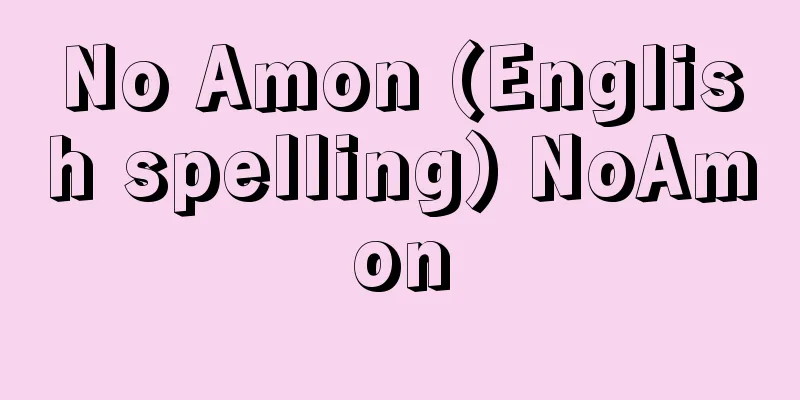Kaifusou - Kaifusou

|
A collection of Chinese poetry. 1 volume. The author is unknown, but there are theories that it was Oumi Mifune, Fujii Hironari, or Isonokami Yakatsugu. It was completed in 751 (Tenpyo Shoho 3) (according to the preface). It contains 120 Chinese poems by 64 Japanese poets over a period of about 80 years from the Omi period to the Tenpyo period in the middle of the Nara period, arranged roughly in chronological order and by author in one volume. Some poems are accompanied by prefaces (6 volumes), and some authors are accompanied by brief biographies in Chinese (9 volumes), making it the only complete collection of ancient Chinese literature in Japan. The works tend to be written for banquets and in response to imperial orders, mainly at the imperial court, and also include a few poems, showing clear signs of learning from Chinese poetry of the Six Dynasties and early Tang Dynasties. The main authors include Prince Otomo (Emperor Kobun), Prince Otsu, Emperor Mommu, Fujiwara no Fubito, Prince Nagaya, Fujiwara no Fusasaki, Umakai, Manri, and Isonokami Otomaro. Prince Otsu, who was executed in 686 (Shucho 1) for a treason case, is famous for his poem "The golden crows rise from the western palace, the sound of the drums calls for a short life, the spring road is not a guest, this evening I leave home" along with "The ducks crowing in the Iware pond at Momozutafu, I have only seen them today, the clouds are rolling down" from the Manyoshu. [Kurachuu Susumu] "A Study of Kaifu-mo, by Ohno Tamotsu (1957, Sanseido)" ▽ "The Great Series of Japanese Classical Literature 69: Kaifu-mo and Others, edited by Kojima Noriyuki (1964, Iwanami Shoten)" ▽ "The Reprint of the Complete Works of Japanese Classics [Heianshi Kashu 1]: Kaifu-mo, compiled and edited by Yosano Hiroshi and others (1982, Gendai Shichosha)" ▽ "Study of the Nihon Shoki, Volume 21, edited by Yokota Kenichi (1997, Hanawa Shobo)" ▽ "The Complete Translation and Annotation of Kaifu-mo, by Eguchi Takao (2000, Kodansha Academic Library)" ▽ "Annual Collection of Essays on Japanese Literature, Ancient Japan 1, edited by the Academic Literature Publishing Committee (2001, Hobun Publishing)" Source: Shogakukan Encyclopedia Nipponica About Encyclopedia Nipponica Information | Legend |
|
漢詩集。1巻。撰者(せんじゃ)については、淡海三船(おうみのみふね)説、葛井広成(ふじいのひろなり)説、石上宅嗣(いそのかみのやかつぐ)説などがあるが未詳。751年(天平勝宝3)成る(序文による)。近江(おうみ)朝以降、奈良朝中期の天平(てんぴょう)ごろまでの約八十数年間のわが国の詩人64人の漢詩120首を、ほぼ時代順・作者別に配列して一巻にまとめている。作品によっては詩序を付したもの(6編)、作者によっては漢文による略伝を付したもの(9編)があり、わが上代漢文学の総集として唯一のもの。その作品傾向は、宮廷を中心とした侍宴(じえん)や応詔の作が多く、少数の詠物詩をも含んでいて、中国の六朝(りくちょう)・初唐詩に学んだ跡が濃厚。おもな作者には、大友皇子(弘文(こうぶん)天皇)、大津皇子、文武(もんむ)天皇、藤原史(ふびと)、長屋王(ながやのおおきみ)、藤原総前(ふささき)、同宇合(うまかい)、同万里(まろ)、石上乙麻呂(おとまろ)らがある。686年(朱鳥1)謀反事件で刑死した大津皇子の「金烏臨西舎 鼓声催短命 泉路無賓主 此夕離家向」は、『万葉集』の「ももづたふ磐余(いはれ)の池に鳴く鴨(かも)を今日のみ見てや雲がくりなむ」とともに有名。 [藏中 進] 『大野保著『懐風藻の研究』(1957・三省堂)』▽『小島憲之校注『日本古典文学大系69 懐風藻他』(1964・岩波書店)』▽『与謝野寛ほか編纂校訂『覆刻日本古典全集〔平安誌歌集1〕懐風藻』(1982・現代思潮社)』▽『横田健一編『日本書紀研究 第21冊』(1997・塙書房)』▽『江口孝夫全訳注『懐風藻』(2000・講談社学術文庫)』▽『学術文献刊行会編集『国文学年次別論文集 上代1』(2001・朋文出版)』 出典 小学館 日本大百科全書(ニッポニカ)日本大百科全書(ニッポニカ)について 情報 | 凡例 |
Recommend
Christmas pantomime
...Because pantomime does not use spoken language...
Werfel, U.
…In animal stories, K. Knaak and F. Steuben made ...
Equestrian Show - Kyokubashibai
...Female acrobats, who appeared in the Horeki pe...
S. Fischer Verlag
Fischer is a leading German literary publisher fou...
Buddhavaṃsa (English spelling)
… In addition to the aforementioned Pāli texts, e...
Cabaret Voltaire (English spelling)
…During World War I, the neutral Swiss city of Zu...
discriminatory price policy
In addition to these basic pricing policies, ther...
Ovis aries (English spelling) Ovisaries
… Even though sheep are not used much as a source...
Chinese Movies - Chinese Movies
The first film screening in China was in August 1...
joke
…The expression “play on the brakes” is a modern ...
Centripetal hypertrophy
… refers to the thickening and enlargement of the...
Phytotron
…Similar experimental research facilities were su...
Inkin Sarasa
…Similar techniques are also seen in Java, Bali, ...
Croomia japonica (English spelling) Croomia japonica
…[Tetsuichi Yahara]. … *Some of the terminology t...
Shiramine Shrine - Shiramine Shrine
Located in Kamigyo Ward, Kyoto City. Formerly a go...









